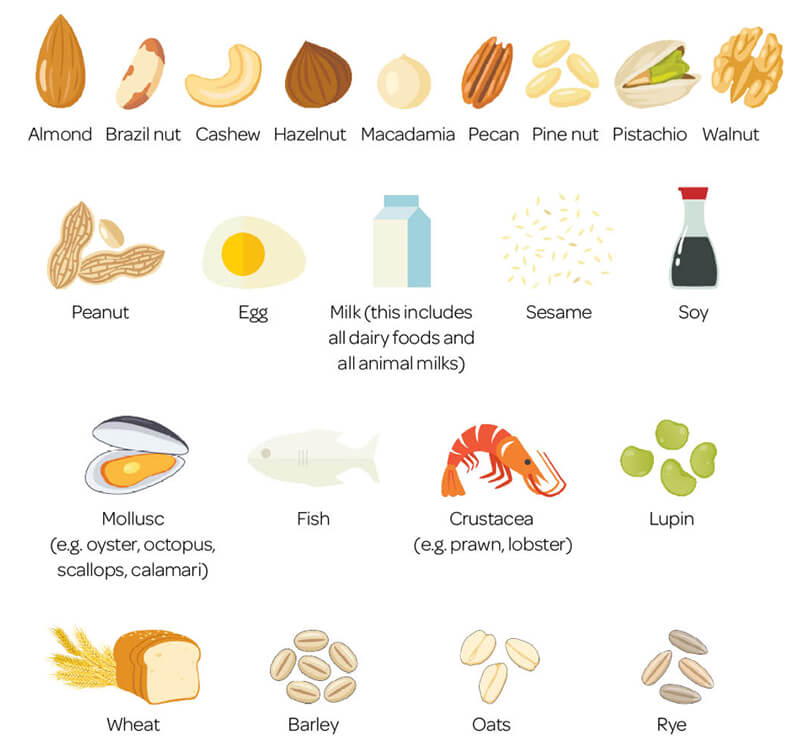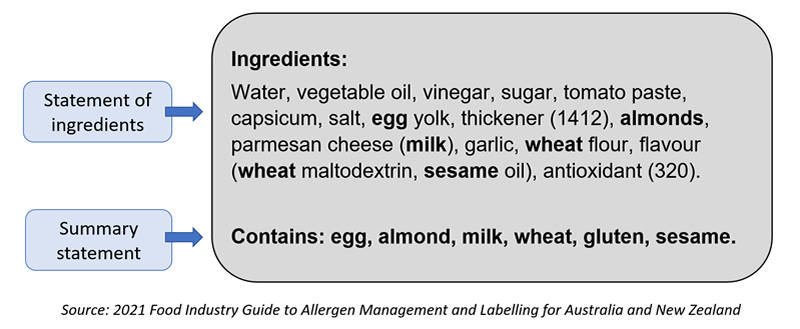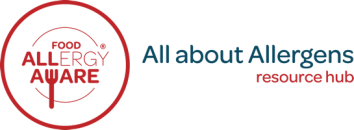Food labelling
information
Reading food labels for food service
It is important to check the food label when buying food every time you purchase a product. Manufacturers can change ingredients and processes at any time, so the allergens in foods can change without you knowing.
Update your food allergen menu matrix when products change, or if you change to a different product.
Allergen information on food labels
In Australia, by law under the Food Standards Code, food packaging must display the most common food allergens. This includes imported foods.
The allergens that must be shown are:
- peanut
- tree nuts (e.g. almonds, cashews)
- egg
- cow’s milk (this includes all dairy foods)
- fish
- crustacea (e.g. prawns, lobster)
- sesame seeds
- soy/soybeans
- cereals containing gluten and their products, namely, wheat, rye, barley, oats, spelt and their hybridised strains (e.g. triticale)
- lupin
The Food Standards Code also requires that added sulphites in concentrations of 10mg/kg or more must be shown on food labels of packaged foods.
The allergens must be declared if they are included in the product as:
- An ingredient
- Part of a compound ingredient (e.g. if milk chocolate is present as an ingredient in a biscuit)
- A food additive
- A processing aid
Videos about Precautionary Allergen Labelling (PAL) statements
These two videos explain more about PAL statements.
When a food does not have to have a label (such as food made and packaged in bulk for caterers, or food served in cafes, restaurants and takeaway outlets), then the seller must provide accurate information about food allergens to customers when they ask for it.
New labelling laws in Australia - Plain English Allergen Labelling (PEAL)
On 25 February 2021, there was a change to the Food Standards Code about the way food allergen information is shown on labels. The change is called Plain English Allergen Labelling (PEAL). Allergen information must now be written using simple, plain English names in bold text and in a specific location on the label to make it easier to see if an allergen is in the food. For example, the word 'egg' must be used rather than just the name of the protein in the egg, for example 'albumin'.
Some other important changes under the new PEAL law include:
- The name of the specific tree nut (almond, Brazil nut, cashew, hazelnut, macadamia, pecan, pine nut, pistachio and walnut) must be included in the ingredients list and in the summary statement. The term ‘tree nut’ cannot be used.
- The specific name of the gluten containing cereal must be stated in the ingredients list as either wheat, barley, oats or rye. When wheat is present, it must also be included in the summary statement.
- ‘Gluten’ must appear in the summary statement whenever gluten from wheat, rye, oats or barley (or their hybrids) is present. The term ‘Cereals containing gluten’ cannot be used.
- Fish, crustacea and mollusc must be separately declared in both the ingredients list and summary statement.
Under the new labelling law (PEAL), the foods shown in the image below must be written in the statement of ingredients using their plain English name:

How to read food labels that meet the new PEAL law
Under the new labelling law, common food allergens must be listed with the plain English name alongside the actual ingredient name. This is shown in the example below.

In the statement of ingredients, allergens must be written:
- In bold font that stands out from the other ingredients.
- In the same size font as other text.
The allergens must also be listed in a summary statement beginning with the word ‘contains’. The summary statement must be next to, but separate from, the ingredient list. It can be above, below or on either side of the ingredient list.
Food companies have been given some time to make these changes to product labels. All products must comply with the new labelling laws by 25 February 2026. Until then, you will need to know how to read labels that comply with both the new and old labelling requirements.
Allergy & Anaphylaxis Australia (A&AA) has detailed lists of ingredient names for the common food allergens. These Food Allergen Cards can help you understand food labels that are not using plain English names yet.
Make sure you check the packaging carefully because plain English names may not have been used yet. Read all ingredient information on the packaging, not just allergen summary statements, because under the old law, summary statements are voluntary and not regulated so may not be very accurate.
Further information about the Food Standards Code is available from the FSANZ website: www.foodstandards.gov.au/code/Pages/default.aspx
Food that is not packaged (Unlabelled foods):
- Some foods may be supplied unpackaged and without a label, for example bread from a bakery or meat products from a butcher.
- These foods must be supplied with ingredient and allergen information, for example on a product information form (PIF), or product specification sheet.
- Contact your supplier if you need more information about ingredients or allergen content of products.
- Update your allergen menu matrix when ingredients or products change.
Reading labels for wheat allergy and coeliac disease
It is easy to be confused between wheat allergy and coeliac disease and how to read labels for these two conditions.
What is gluten?
Gluten is a type of protein found in wheat, rye, barley, oats and cereals that are bred from these grains (such as triticale).
Wheat allergy and gluten
- A person with a wheat allergy can have a life threatening, immediate allergic reaction to any of the proteins found in wheat.
- People with a wheat allergy must avoid wheat, but they may be able to eat other cereals that contain gluten - such as rye, barley and oats, if they are not allergic to them.
- For a person with a wheat allergy, it is important to check for all wheat ingredients on a food label, even in those foods that are labelled 'gluten-free'. You should also check if they are allergic to any other grains in addition to wheat.
Coeliac disease and gluten
- Coeliac disease is an autoimmune condition, not a food allergy.
- People with coeliac disease must avoid all gluten and all grains that contain gluten.
- If someone with coeliac disease eats gluten, it will not cause a life threatening reaction, but it can cause gastrointestinal symptoms such as nausea, vomiting and diarrhoea and may cause serious long term health problems.
- People with coeliac disease must not be given foods containing gluten or contaminated with gluten.
Reading labels for milk (dairy) allergy and lactose free products
What does lactose free mean?
- Lactose is a type of sugar in milk.
- Lactose free products have had the lactose sugar taken out.
- People with lactose intolerance need to eat lactose free products because they can’t digest lactose sugar very well.
- People with milk (dairy) allergy cannot eat lactose free dairy products because they still contain the milk (dairy) protein that causes allergic reactions.
Lactose free dairy products contain milk protein and must not be given to people with a milk (dairy) allergy.
- Milk (dairy) allergy and lactose intolerance are different.
- People with a milk allergy are allergic to the protein in milk. So even if the milk is lactose free, it may cause anaphylaxis in a person with milk (dairy) allergy.
- Remember - milk allergy means all dairy products (such as milk, butter, yoghurt, cheese) must be avoided, even if they are lactose free.
What about dairy free products?
- Dairy free products are made from nuts or plants and should not contain any dairy protein at all.
- However, the ingredient list and any precautionary allergen labelling (for example, 'may contain') should always be checked to see if they contain any milk products.
- Some coconut milks, drinks or creams contain milk (dairy), so they are not suitable for people with a milk (dairy) allergy.
- Be aware that vegan foods can sometimes contain small amounts of milk and egg. Never presume they are completely milk or egg free unless they are marked milk or egg free.
What about precautionary allergen labelling statements?
- Precautionary allergen labelling (PAL) statements are used to warn that a food product might be cross contaminated with an allergen and could be a risk to someone with a food allergy.
- Cross contamination can happen during growing, transport, storing and making the food.
- Examples of PAL statements include
- ‘May contain…’
- ‘Made on equipment that also produces products containing…’
- ‘allergen warning…’
- These statements are voluntary and not regulated by the Food Standards Code. Companies can choose to use them, or not.
- You need to check the whole label for PAL statements because not all companies put this information near the ingredients list.
- Customers with food allergies should not be served foods or ingredients with PAL statements without first talking to them about the product (e.g. a product labelled ‘may contain traces of peanut’ should not be given to a customer who is allergic to peanuts).
- If you would like more information about the risk of cross contamination for a product, contact the manufacturer of the product or your supplier for more information.
Content updated June 2023
